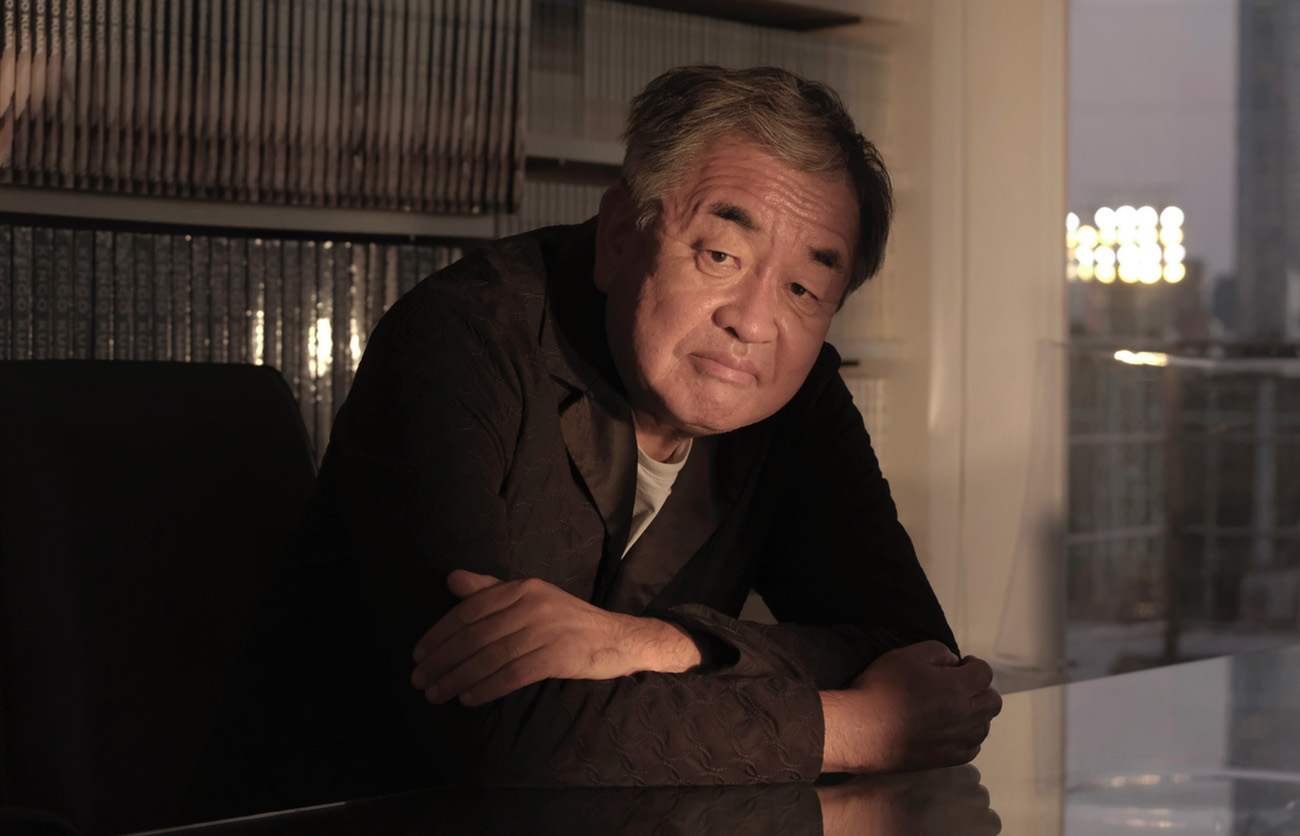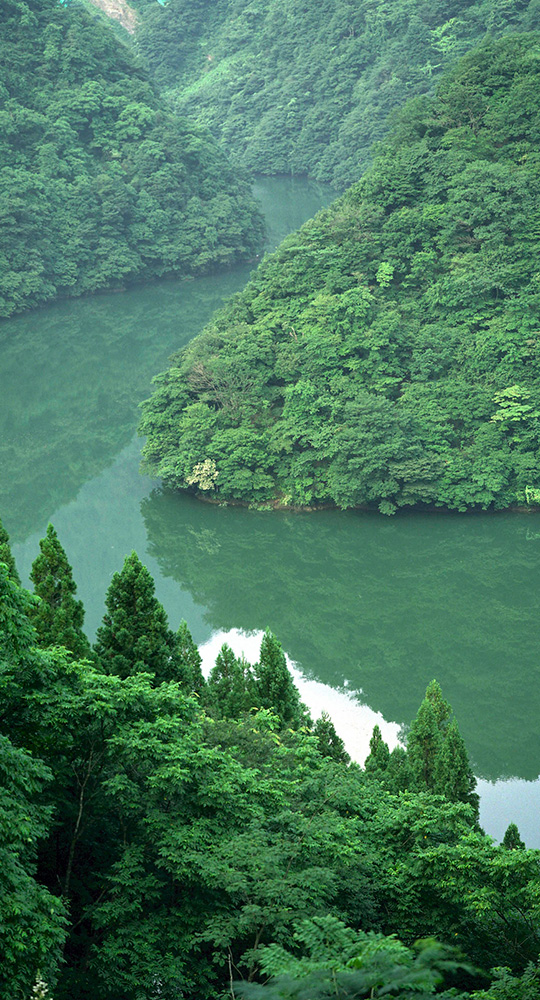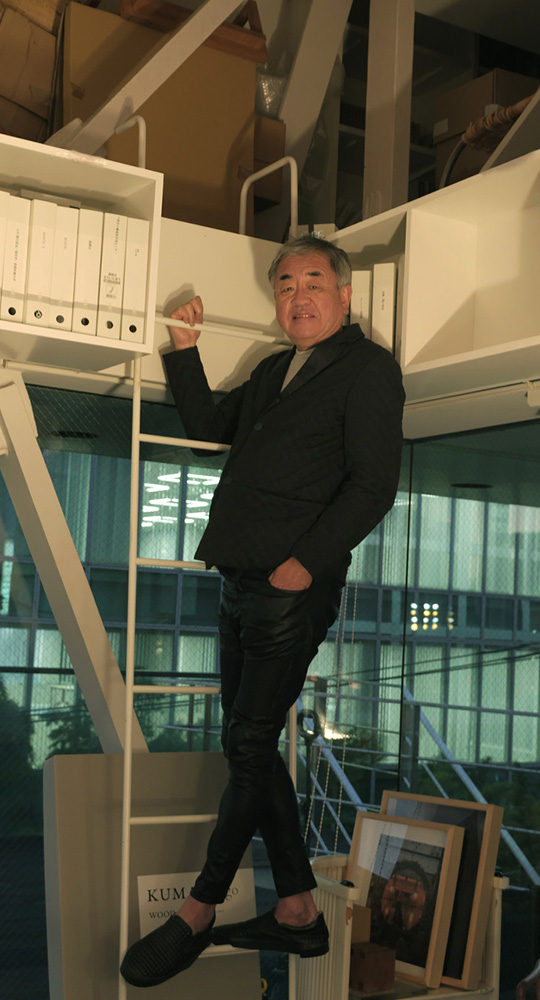
隈さんの建築作品には周辺の風景との連続性、その調和が感じられるのですが、建築家にとってArchitectとLandscapeとはどのような関係なのでしょう?
隈|
西洋建築では、建物ができた段階で、庭をデザインする。つまり、まず建築有りきで、建物の完成後に庭をつくるという関係にあります。ただ、日本は逆です。庭がまず存在し、そこに建築を建てるという順序です。日本人には自然への敬意、畏敬があって、このような順序となっていたのでしょう。ただ、明治に西洋建築の文化や思考が入ってきたことで、建築と庭の関係性が西洋的なそれに変わってしまった感があります。
僕は建築デザインをする際は、僕のデザインを理解してくれるランドスケープデザイナーとして参画してもらい、プロジェクトを進めてきたのですが、そもそも論として、建築予定地ではどんな庭の要素(水路の整備や盛り土)を盛り込めるのかが最初から検証できたなら、グランドデザインの発想力がより豊かになると感じてきました。そんなこともあり、社内にランドスケープ部門を新設し、設計の最初からランドスケープと一緒に考えるやり方を現実の設計スタイルとするアクションに着手したところです。
僕にとっての建築、そして庭では、「歩く」ということがとても大切な行為なんです。自分が移動していくことを感じる「流れ」を表現する、これは一枚の写真では表現できない建築と庭が奏でる物語です。「歩く」ことには、人間としての時間の過ごし方が反映されるはずですから。

広川泰士『南砺』シリーズより


そういう意味では、渋谷の『THE TOKYO TOILET』プロジェクトで手掛けられた鍋島松濤公園の公共トイレ「森のコミチ」には散歩道がありますね。
隈|
あの建築では、トイレに至るまでの道のデザインに一番エネルギーを注ぎました。どの道を歩くかも選べ、そこに至る風景も「流れ」として感じていただけるように設計しました。
隈さんが手がけられる建築には、普通の生活者が関わる日常的な施設整備も数多くありますね。これらの公共建築物には、「気づきや学び」と「ちょっとした驚きと喜び」が散りばめられているように感じます。隈さんにとって「建築の公共性」とは、どのようなものでしょうか?また、そのようにお考えになられるようになったのはいつからですか?
隈|
80年代からです。アメリカから帰国後、事務所を開設し、それなりに大きなプロジェクトも依頼されるようになっていました。それがバブル崩壊で、一挙にキャンセルになったのです。が、この事態に落胆と言うより、僕はむしろ清々しい気持ちになれたのです。
当時扱っていた案件はいずれもクライアントのビジネスや会社の存在感を社会に誇示することを目的とする建築ばかりでした。周囲との調和などは論外で、とにかく「目立つ」ことが求められました。こうしたビジョンは僕が提唱している『負ける建築』、『反オブジェクト』という建築哲学の対極にある価値観です。
80年代から関わってきた四国の梼原町の公共建築群(http://www.town.yusuhara.kochi.jp/kanko/kuma-kengo/)では、その町に住む人に愛され、町のためになる建築をデザインすることに集中してきました。つまり、地元の森林資源をふんだんに使用し、その土地柄がもつあたたかさ、やわらかさを伝え、町民のみなさんや町外から訪れる方々を親しげに迎え入れる建物をつくることです。
まさに僕が考える『反オブジェクト』に合致した建築の在り方です。
梼原との出会いによって僕の建築への考え方がガラッと変わったんです。



市町村の公共建築、渋谷の公共トイレ「森のコミチ」、「スターバックス太宰府天満宮表参道店」、いずれも知らないうちに建築に魅了され、建築資材や手法への気付き、デザイン力への感動を与えてくれます。
隈|
建築とは、そこに集う人々が気持ちのいい時間を過ごせる空間であるべきです。自然を感じたり、日本の伝統技術や素材の美しさに出会い、楽しんでくれることが僕の一番の喜びです。

Your architecture has a sense of continuity and harmony with the surrounding landscape. What is the relationship between Architect and Landscape for architects?
KK|
In Western architecture the garden is designed when the building has been completed. In other words, the relationship dictates that architecture comes first, and then a garden is completed after the building has been built. However, in Japan it is the opposite. The garden exists first, and then the architectural design is constructed there. This order is probably because Japanese have respect and awe for nature. However, with the introduction of Western architectural culture and thinking during the Meiji Era, I feel that the relationship between architecture and gardens has unfortunately changed to that of Western architecture.
When designing, I ask for the participation of a landscape designer who understands my architectural design to proceed with the project. I feel that if we can verify from the beginning what kind of garden elements (such as waterway maintenance and embankments) can be included in the planned construction site, the creativity of the overall grand design will be enriched. With that in mind, we have just set up a new landscape department within the company. From the initial design stages, we have started thinking of design style together with landscape.
For me, ‘walking’ is a very important act within architecture, and in the garden. A ‘flow’ that expresses movement is a story of the architecture and garden that cannot be expressed in a single photo. ‘Walking’ should reflect how you spend your time as a human being.



In that sense, there is a walkway in the ‘Mori no Komichi’ public toilet in Nabeshima Shoto Park, part of Shibuya’s ‘THE TOKYO TOILET’ PROJECT, isn’t there?
KK|
For that architecture, I put the most energy into the design of the walkway leading up to the toilet. We designed it so you can choose which way to walk, and the scenery leading up to it can be felt to ‘flow’.
Much of your architecture involves daily facility developments for ordinary people. I feel that these public buildings are studded with ‘awareness and learning’, and ‘little surprises and joy’. What does ‘public space’ in architecture mean to you? And when did you start thinking that way?
KK|
It began in the 80s. After returning from the USA, I opened an office and was asked to do some big projects (http://www.town.yusuhara.kochi.jp/kanko/kuma-kengo/). That was when the bubble burst and it was all cancelled at once. However, rather than feeling discouraged by the situation, I felt refreshed. All of the projects we were involved with at that time were architectural designs aimed at showing off the presence of the business or company to society. Harmony with the surroundings was out of the question, with the main aim being to ‘stand out’. These visions are the polar opposite of the architectural philosophy of ‘Architecture of Defeat’ and ‘Anti-Object’ that I advocate.
The public buildings in Yusuhara Town, Shikoku, that I have been involved in since the 1980s have focused on architectural design that benefits the town and is loved by the people who live there. We use abundant local forest resources, convey the warmth and gentleness of the land, and create a building that welcomes the residents and visitors to the town. This aligns exactly with my ‘Anti-Object’ architectural vision. My encounter with Yusuhara Town changed my way of thinking about architecture.



Municipal buildings, Shibuya public toilet ‘Mori no Komichi’, ‘Starbucks Dazaifu Tenmangu Omotesando’. In each instance, you find yourself fascinated by the architecture, aware of building materials and methods, and impressed by the design skills.
KK|
Architecture should be a space where the people who gather there can pleasantly spend time. My greatest pleasure is for people to enjoy the space, feeling nature, and bringing together the beauty of traditional Japanese techniques and materials.